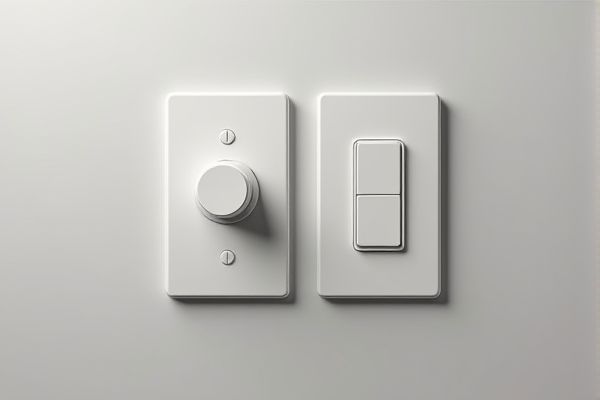
A dimmer switch allows you to adjust the brightness of your lighting, providing customizable ambiance and energy savings, while a standard switch simply toggles lights on or off at full intensity. Discover which option best suits your needs and how to enhance Your home's lighting by reading the rest of the article.
Table of Comparison
| Feature | Dimmer Switch | Standard Switch |
|---|---|---|
| Functionality | Adjusts light intensity from low to high | Turns light ON or OFF only |
| Energy Efficiency | Reduces energy use by lowering brightness | Full energy usage when ON |
| Compatibility | Works with dimmable bulbs (LED, incandescent) | Works with all standard bulbs |
| Cost | Higher initial cost | Lower initial cost |
| Installation | Requires compatible wiring, may need professional | Simple, DIY-friendly |
| Use Cases | Ambient lighting, mood setting | Basic ON/OFF control |
| Lifespan | Potentially longer bulb life by dimming | Standard bulb life |
Introduction to Dimmer Switches and Standard Switches
Dimmer switches allow precise control of lighting intensity by adjusting voltage levels supplied to bulbs, enhancing ambiance and energy savings. Standard switches function as simple on/off toggles, providing basic control without varying light output. Understanding these differences helps optimize lighting design for comfort and efficiency.
How Dimmer Switches Work
Dimmer switches regulate lighting intensity by adjusting the voltage delivered to the light bulb, often using TRIAC-based phase-cutting technology to modulate power flow. This method allows for precise control over brightness levels, enhancing energy efficiency and extending bulb lifespan compared to standard switches. Standard switches operate simply by opening or closing the circuit, providing only on or off states without variable light control.
How Standard Switches Operate
Standard switches operate by simply opening or closing an electrical circuit, allowing full current to flow to the light fixture or cutting it off entirely. Unlike dimmer switches, they do not regulate voltage or adjust brightness levels, providing a binary on/off control. Your lighting setup with standard switches ensures straightforward, reliable operation without the complexity of variable light intensity.
Key Differences Between Dimmer and Standard Switches
Dimmer switches allow you to adjust the brightness of your lighting, offering customizable ambiance and energy savings, while standard switches only provide an on/off function. Dimmer switches often require compatible bulbs like LEDs or incandescent, whereas standard switches work universally with most bulb types. Your choice influences not only lighting control but also energy consumption and bulb longevity.
Energy Efficiency and Savings
Dimmer switches enhance energy efficiency by allowing users to adjust light levels, reducing electricity consumption compared to standard switches that operate only at full power. By lowering brightness, dimmers can extend bulb life and decrease energy costs, contributing to significant savings on utility bills over time. Utilizing dimmer switches in frequently used areas maximizes energy conservation without sacrificing lighting quality.
Installation and Compatibility Considerations
Dimmer switches require compatible bulbs such as dimmable LEDs or incandescent bulbs to function correctly, while standard switches work with any bulb type. Installation of dimmer switches may involve rewiring and verifying voltage compatibility, making it slightly more complex than the straightforward wiring of standard switches. Your choice depends on whether you want adjustable lighting levels and if your existing fixtures support dimming technology.
Cost Comparison: Dimmer vs Standard Switch
Dimmer switches typically cost between $15 and $50, while standard switches range from $5 to $15, making dimmers a higher upfront investment. Installation costs can also be higher for dimmers due to more complex wiring requirements. Your choice depends on whether you prioritize energy savings and ambiance control over initial affordability.
Lighting Control and Ambience
Dimmer switches provide precise lighting control by allowing users to adjust brightness levels, enhancing ambience and creating a customizable atmosphere for any room. Standard switches offer simple on/off functionality, limiting the ability to modify lighting intensity and mood. Using a dimmer switch improves energy efficiency and extends bulb life while providing versatile lighting options to suit different activities and times of day.
Safety and Maintenance Factors
Dimmer switches reduce electrical load by adjusting light intensity, minimizing heat generation and extending bulb lifespan, which contributes to safer operation compared to standard switches that operate at full power. Maintenance for dimmer switches involves ensuring compatibility with LED bulbs to prevent flickering or damage, while standard switches typically require less frequent checks but offer no control over light output. Proper installation and regular inspection of both switch types help prevent wiring issues and electrical hazards, promoting overall home safety.
Which Switch is Right for Your Needs?
Dimmer switches offer adjustable lighting control, ideal for creating ambiance and conserving energy, while standard switches provide simple on/off functionality suited for basic lighting needs. Choosing the right switch depends on your preference for mood lighting flexibility versus straightforward operation and cost-effectiveness. Consider the type of bulbs used and the room's lighting requirements to ensure optimal performance and compatibility.
 homyna.com
homyna.com